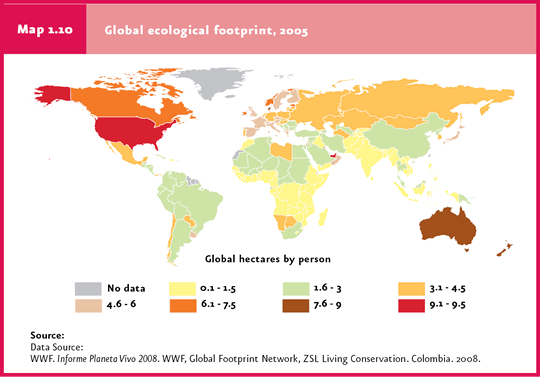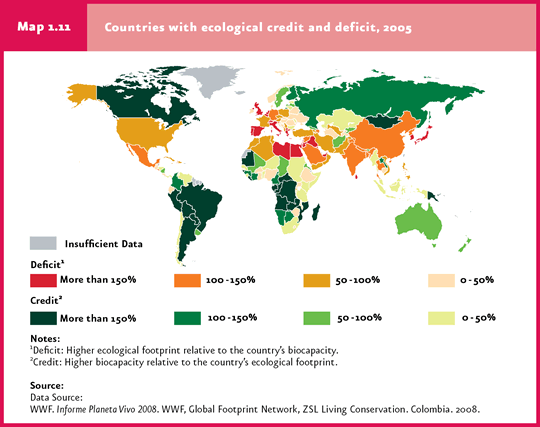
The estimated human consumption at a global level is 23.8% of terrestrial net primary productivity; 35% of marine productivity, extracted mostly from continental shelves by industrialized fisheries, and 54% of accessible fresh water. |
In 2005, the Earth’s area required to meet human needs surpassed the available area in 30%. |
Mexico had an HDI of 0.8031 in 2004 and an ecological footprint of 3.4 in 2005. Hence, Mexico belongs in the group of countries with an ecological deficit and a high HDI. |
Goal 7 of the Millennium Development Goals sets forth the necessity of warranting environmental sustainability through objectives such as the inclusion of sustainable development principles within national policies and programs, as well as the reduction of the loss of natural resources and biological diversity. |
| CHAPTER 1. POPULATION AND ENVIRONMENT |
Even though human populations account for less than 1% total heterotroph biomass5 on Earth, man is the major consumer of the planet’s resources. The estimated human consumption at a global level is 23.8% of terrestrial net primary productivity (Haberl et al., 2007); 35% of marine productivity, extracted mostly from continental shelves by industrialized fisheries (Pauly and Christensen, 1995), and 54% of the accessible fresh water (Postel et al., 1995). According to the Millennium Ecosystem Assessment (2005), man has modified natural ecosystems more rapidly and extensively over the past 50 years than in any other period of human history, primarily to meet the growing needs for food, water, wood, fibers and fuel. These modifications have resulted in substantial benefits in terms of human well-being and economic development, but at the expense of negative environmental consequences not included in production costs. For example, in technified agriculture, food production does not consider off-site damage, such as eutrophication caused by fertilizers and agrochemical leaching; in the transportation sector, the cost of fuels neglects the health issues associated with carbon monoxide, nitrogen oxides and other pollutant emissions. One of the ways in which the pressure of man on ecosystems has been assessed is through the so-called Ecological Footprint. The World Wildlife Fund (WWF, 2008) has defined it as an indicator of human demand on ecosystems in terms of the areas dedicated to agriculture, cattle-raising, forestry and fishing, those allocated to infrastructure and settlements and those required for the absorption of carbon dioxide derived from fuel combustion. The ecological footprint of a person, country or the entire world is the sum of the global hectares6 of all the areas mentioned above (Map 1.10). The ecological footprint does not include fresh water consumption, since its demand and use cannot be expressed as global hectares, although an equivalent “water footprint” has already been proposed (refer to the Water chapter).
The difference in global hectares between a country’s ecological footprint and its biocapacity7 reveals the existence of either an ecological deficit or surplus in terms of natural resources. In 2005, the Earth’s estimated biocapacity was 13.6 million global hectares, or 2.1 global hectares per person. The ecological footprint for the same year was 17.5 million global hectares, or 2.7 global hectares per person. This means that the area required to meet human needs surpassed the available area in 30%, clearly evidencing unsustainable conditions in the use of natural resources. At a regional level, North America has the highest deficit, since an average inhabitant uses 2.7 global hectares in excess of the region’s available area; the European Union ranks second, with a deficit of 2.4 global hectares per person. At the other end, Latin America, as a whole, has an average ecological credit of 2.4 global hectares per person. Specifically, Mexico is a country with an ecological deficit, having an ecological footprint and a biocapacity of 3.4 and 1.7 global hectares per person, respectively; that is, a deficit of 1.7 global hectares per person. In 2005, Mexico's ecological footprint ranked 43 worldwide (refer to Box Mexico’s Ecological Footprint). In 2005, 85 countries had an ecological deficit, resulting from both the consumption of imported natural resources and the overexploitation of their own resources. This group includes 23 countries which in 2005 had an annual per-capita GDP of more than $ 20 thousand USD, but also 22 countries with an annual per-capita GDP of less than one thousand USD (World Bank, 2008). However, even though many poor countries have an ecological deficit, the most developed countries control access to the majority of the environmental services, use them at a highest rate and, nevertheless, are shielded against fluctuations in availability as they are able to import resources from abroad due to their economic welfare. To note, the ecological credit that many developed and developing countries display does not necessarily mean that natural resources are properly managed, nor that these are not susceptible to degradation (Map 1.11).
Generally, countries with a high HDI have ecological footprints above the world’s average biocapacity (2.1 global hectares per person), that is, they have an ecological deficit. This means that their economic and social development is not bound to sustainable natural resource management. Mexico is one such case, having a HDI of 0.8031 in 2004 and an ecological footprint of 3.6 in 2005. The United Arab Emirates and United States of America are the most extreme cases, with the highest ecological footprints worldwide (9.5 and 9.4 global hectares per person, respectively); at the same time, these two countries belong to the group of countries with the highest HDIs (0.868 and 0.951, respectively). On the other end, there are countries with an ecological footprint below the world mean availability (i.e. their have ecological credit), but their HDI is low, as in the case of many Sub-Saharan countries (Figure 1.10).
Environmental sustainability has been explicitly set forth as a component of development in the Millennium Development Goals (UN, 2008; Goal 7), along with objectives related to health, education and social equality. Although environmental goals were rather broad in the original proposal, in 2007 an extension was proposed including subjects like climate change caused by greenhouse gas emissions, biodiversity protection (threatened or endangered species) and aquatic populations. This evidences the recognition on the importance of the environment for achieving sustainable development. In fact, it has been acknowledged that an undisturbed environment is required to achieve some of the social objectives (for example, the reduction in some diseases). The challenge to address in the future is achieving social and economic development with no further reduction of the invaluable natural capital still available. For this reason, environmental conservation, the promotion of human development and the reduction of poverty are all tasks which should be planned in a coordinated and inclusive manner for these to be effective. Achieving the above mentioned goals require the implementation of novel schemes that combine environmental protection with benefits for the poor (for example, payments for environmental services) aimed at promoting social development while bringing benefits or, at least, causing no harm to ecosystems (as in well-managed ecotourism).
Notes 5Heterotrophic organisms are those that get energy from other organisms.
|


